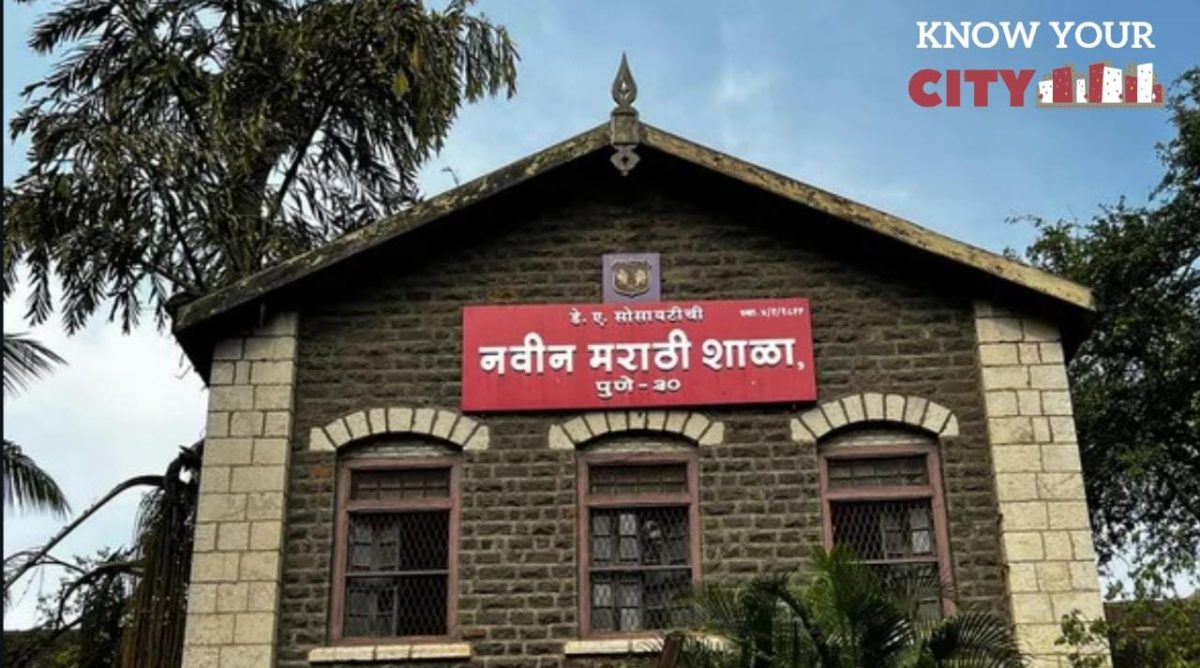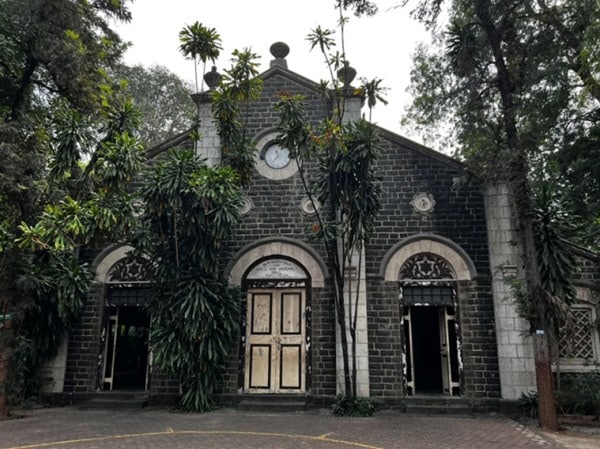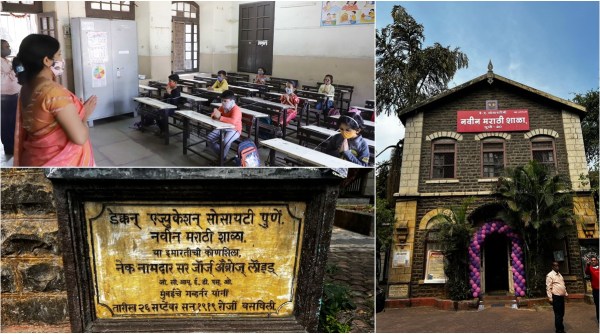 Located in Shaniwar Peth, in a grand colonial-era building, was the Navin Marathi Shala that had been founded by a group of stalwarts of the Independence struggle.
Located in Shaniwar Peth, in a grand colonial-era building, was the Navin Marathi Shala that had been founded by a group of stalwarts of the Independence struggle. In 1954, two freedom fighters from Mahatma Gandhi’s movements, Usha and Vasant Alekar, were looking for a suitable school — that imparted education in Marathi and not English — for their son Satish Alekar, now a famous playwright. Located in Shaniwar Peth, in a grand colonial-era building, was the Navin Marathi Shala that had been founded by a group of stalwarts of the Independence struggle, Bal Gangadhar Tilak, Gopal Ganesh Agarkar, Vishnushastri Chiplunkar and Mahadev Namjoshi. Since 1899, the school had been working to promote national pride and duty among its pupils and boasted eminent educationists, such as Maharshi Dhondo Keshav Karve, KR Kanitkar and VK Joag, as its earliest principals.
The mission of the school was evident in its time-table. “There was a separate section for the children’s library, which was an innovative concept at the time. Every class had periods set aside to spend time in the library. We would have to sign a roster and pick up books. All furniture was adjusted according to the height of pupils. We also got an hour every day at the little farm that had been created in the middle of the school campus, where we learnt how rice and other crops are grown. We have first-hand knowledge of sowing seeds, sampling the soil and replanting paddy,” says Alekar, the batch of 1958, adding that among other eminent students were Paranjpye and Gauri Deshpande.
These rites still set apart the Navin Marathi Shala as it celebrates its 123rd anniversary on January 4. A new generation — the school spans Class I to IV — is now learning the secrets of agriculture, the library is lined with modern titles and the pottery class brings out moulded and painted Ganesha idols every Ganeshotsav. “Today, the world is waking up to climate change. The founding fathers of the school had tried to address the problem long ago by ensuring that children understood the value of earth, plants and working with their hands. The tradition of Navin Marathi Shala is to go beyond classroom teaching and impart value-based education that will instill responsibility in children,” says the present principal Kalpana Shantaram Wagh.
In colonial India, it was institutions of the British government and Christian missionaries that were providing public education. Private enterprises in education were discouraged. According to the Deccan Education Society (DES) website, Chiplunkar, Tilak, Agarkar and other leaders felt this system was inadequate in generating leadership for “industrial regeneration of a self-governing nation”. In 1880, Chiplunkar, Tilak and Namjoshi started New English School with the objective of offering affordable education to the masses. On October 24, 1884, when DES formally came into existence with the idea of “providing education to rouse the intellect, drooping will and slumbering conscience of the fallen countrymen”, the New English School was brought under it.
The Navin Marathi Shala was a branch of the New English School. According to The History of The Deccan Education Society, compiled and in part written by PM Limaye, Professor of History and Economics at Fergusson College, in 1935, the Navin Marathi Shala was, originally, a “feeder” school — in terms of numbers of students and quality of their education — for the New English School. “The feeder school, along with the New English School, were affected by the plague epidemic. Nonetheless, its importance was amply justified by the fact that, in the years that followed, the Navin Marathi Shala was able to give, every year, an increasing number of students to the New English School,” writes Limaye.
 Exterior of Navin Marathi Shala.
Exterior of Navin Marathi Shala. There were 108 boys studying in the school in 1901. The Late Prof PN Panse, the Superintendent of the New English School, was also the first Superintendent of Navin Marathi Shala. “The school was housed in Holkar Wada. During the first few years of its career, the school went on making slow and steady progress….it kept to the old ideas and methods of imparting education. The financial situation was improving with the steadily increasing numbers,” writes Limaye. Efforts were, however, being made to improve and modernise the methods of education. By 1905-06, when MV Sane, an enthusiastic and intelligent teacher, was the headmaster, “the latest and improved” initiatives such as object lessons were being followed with “more or less success in all classes”. In 1906-07, the school made several internal improvements, such as writing desks that were fitted for the heights of the students. According to Limaye, “Extra expenditure was incurred with a view to conduct the school on a thorough and scientifically sound basis to make it worthy of rank with the most up-to-date primary schools”
“Originally, the school drew pupils from across Pune, which was, then, a smaller city. As the number of students increased, it became evident that the Navin Marathi Shala needed a new building,” says Bhagyashree Hazare, a member of the faculty, pointing out the cornerstones of the building where the school is now located. The cornerstone had been laid by George Lloyd, the Governor of Bombay, on September 25, 1919. “The school has been at this address since 1923. Three years later, it got its own assembly hall, which was inaugurated by Lady Meherbai Tata, the daughter of Hormusji J Bhabha and wife of Dorabji Tata, the eldest son of Jamsetji Nusserwanji Tata and elder brother of JRD Tata. In 1935, a stage was constructed in the hall and its wooden parts held good until last year, when it had to be replaced,” says Hazare. A number of old structures no longer remain, among them the principal’s cottage and a tiffin room, where pupils would gather to eat together — these have made way for a new building. Another new building houses the library and offices, among others.
 A new generation of students is now learning the secrets of agriculture, the library is lined with modern titles and the pottery class brings out moulded and painted Ganesha idols every Ganeshotsav.
A new generation of students is now learning the secrets of agriculture, the library is lined with modern titles and the pottery class brings out moulded and painted Ganesha idols every Ganeshotsav. “Even 100 years later, the walls of the old building are so strong that we would have difficulty even in hammering a nail into it. When the Panshet dam burst, the water flooded the school and destroyed most of the old documents. After the waters receded, the flood affected were given shelter in the school and were visited by Pt Jawaharlal Nehru,” says Priya Indulkar, a member of the school’s faculty. Nehru might even have been shown a tree growing in the garden — it had been planted on August 15, 1947 to mark the independence of the country.
“Our most important legacy is our students. Fortunately, we have strong customs, such as scout-and-guide programmes, sports and co-curricular activities to build them to be well-rounded individuals,” say Wagh. Alekar remembers watching his first play, a PL Deshpande production performed by a local group, as a child studying at Navin Marathi Shala as well as flute practice with a music teacher in the evenings. In keeping with its history of introducing pupils to performances, the school performed a grand and hi-tech production, titled Geet Ramayan, in 2016 with 1,256 students and entered the pages of World Records India, published by Ahmedabad-based non-profit Genius Foundation, for the “Longest Poetic Spiritual Drama”.
There’s a food memory from the school that Alekar indulges in. “There is a factory called Hindustan Bakery behind the school and we used to get the smell of biscuits being baked in the oven. I used to love to go to the other side of the school, where there was a small outlet of the bakery and we used to buy hot, freshly prepared biscuits. The bakery is still there. I wonder if boys and girls still go to enjoy the fresh biscuits?” says Alekar.
“There was also a knitting factory at the back of the school that produced the popular local undergarment brand. Many things did not survive the Panshet dam disaster. I feel happy that Hindustan Bakery has survived,” he adds.
The school band, however, continues with gusto. “Pupils get into queues and, to the beat of the drums, they march to assembly. After assembly, the band plays again, and the pupils march back to class. The band is a popular part of their activity. It builds discipline while being fun. Due to COVID and other global issues, the future is full of challenges for young students so it is important to give them a solid grounding,” says Wagh, adding that Navin Marathi Shala will always be dedicated to creating a strong youth in service of the nation.
- The Indian Express website has been rated GREEN for its credibility and trustworthiness by Newsguard, a global service that rates news sources for their journalistic standards.

